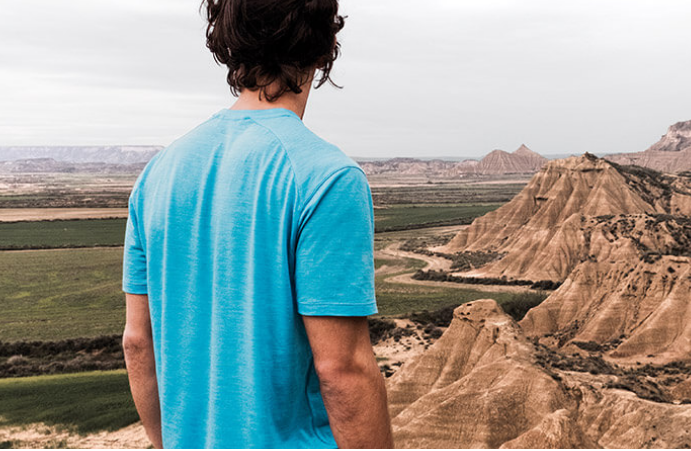
Image credit: icebreaker.com
On one of my first backpacking trips, I went with a 50L backpack packed to bursting. I regretted my decision the entire time. Lugging around too much gear in hot, tropic temperatures was no way to explore the world. What is the worst part about it? I barely used all the stuff I thought I needed.
In a surf camp in Guadeloupe, I met a guy who was wearing a wool t-shirt, of all things. He swore by it, so I decided to test it out.
Quickly, I was hooked on merino wool clothing. It’s exceptional, because it rarely smells bad, no matter how long you put off washing it. It keeps you cool in the heat and warm in the cold, thanks to its insulating properties. It’s easy to dry, and even if it’s wet it will still keep you warm, unlike cotton.
By rationalizing my packing list and swapping out countless cotton t-shirts for two merino wool ones, I was able to reduce my backpack down to a 19L Tom Bihn backpack. Now, I breeze through airports, and I can comfortably hike for hours with all my gear right with me.
However, some of my friends voiced concerns about the ethics of merino wool. They mentioned the treatment of the animals as a particular concern. Therefore, I wanted to look into whether it’s possible to find environmentally and ethically sound merino wool.
I’ll go through the various concerns below.
Treatment of the Sheep
Obviously, I wanted to purchase clothing created out of wool from sheep that were treated humanely.
One practice in sheep-rearing that has rightly raised much concern is ‘mulesing’, or the removal of strips of wool-bearing skin around the breech of a sheep in order to prevent fly strike. Animal rights activists criticize unanaesthetised mulesing as inhumane. Many brands now offer only mulesing-free wool, including Icebreaker, Finisterre, Darn Tough and Patagonia.
It’s also important to consider the treatment of the sheep once they are slaughtered. Patagonia came under scrutiny for the treatment of sheep during slaughter by their Merino Wool supplier, Ovis 21. A video released by PETA forced Patagonia to sever ties with Ovis 21 and re-think their merino wool sourcing.
Environmental Impact
Merino wool itself is a natural material that biodegrades rapidly once disposed of. Ultimately, it’s a natural way to convert grass into a high-performance fiber for clothing.
At the same time, intensive farming has a detrimental impact on the environment, so it’s important that the merino sheep are raised in a sustainable fashion. Making sure biodiversity is maintained and minimizing the impact of pesticides and fertilizers, if used, are all important steps in this process.
One global initiative called the Responsible Wool Standard sets out to create a voluntary global standard that addresses the welfare of sheep and the land they graze on, so you can look out for wool certified to this standard.
Manufacturing Conditions
It doesn’t make much sense to have ethically sourced wool turned into clothing in sweatshops, so I always look into how the brand treats its employees.
Darn Tough is a merino company that only manufactures its socks in Vermont, USA. Finisterre, a British company, has manufacturing facilities in Portugal. Icebreaker has drawn fire in the past for moving their facilities to China.
At the same time, you can argue that manufacturing clothing in a less developed country is not, in itself, problematic. On the contrary, it can be a needed source of growth for the countries involved, as long as the working conditions are humane and environmentally sustainable.
Finding the Brand that Works for You
I found the process of digging into where my clothes come from very illuminating. It gave me a better sense of what goes into creating the clothes I wear.
For me, I was happy with what I found in respect of brands such as Icebreaker, Darn Tough, and Finisterre. After the PETA revelations, Patagonia revamped their wool program to meet stricter requirements, so now I’d add them to the list. I even wrote up a guide to merino wool socks if you want to some ideas of where to start.
Ultimately, it’s up to each of us as a consumer to find the right fit in terms of environmental and ethical concerns.
Written by Thomas Carney
 Thomas Carney is an ultra-light global traveler who is fascinated by high-performance travel gear. He writes about merino wool over at MerinoWoolRocks.com
Thomas Carney is an ultra-light global traveler who is fascinated by high-performance travel gear. He writes about merino wool over at MerinoWoolRocks.com

